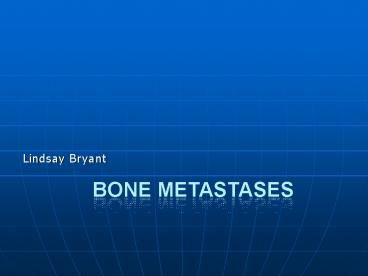Bone metastases - PowerPoint PPT Presentation
1 / 17
Title: Bone metastases
1
Bone metastases
- Lindsay Bryant
2
Nuclear Medicine
- Radiopharmaceutical administered to the patient
and subsequently recording its distribution in
the body over a defined period of time. - Used to detect pathology
- Very sensitive
- Nonspecific
3
Radiopharmaceuticals
- No physiologic response when administered for
diagnostic or therapeutic purposes. Selective
uptake of these compounds by various organs forms
the basis for nuclear imaging - Two components
- main component - distributed
- radionuclide tagged to this component
- Emits gamma rays which permit detection of the
compound - Components localize by active transport,
phagocytosis, etc. - Physiologic function can be assessed, but
spatial resolution is relatively poor
4
Common Nuclear Procedures
- Cardiac studies
- Skeletal studies
- Renograms and renal scans
- Ventilation-Perfusion studies
- PET studies
- Evaluation of neurodegenerative disorders, brain
tumor recurrence, and myocardial viability.
5
Less Common Nuclear Procedures
- Diagnostic thyroid studies
- Hepatobiliary studies
- Brain imaging
- White blood cell studies
- Gastrointestinal bleeding studies
- Lymphoscintigraphy
- Parathyroid scans
6
99mTc bone scintigraphy
- Effective method for screening the whole body for
bone metastases - 99mTc methylene diphosphonate (MDP) is the most
frequently used isotope. - 99mTc planar bone scintiscans help identify
tumors by detecting the increased osteoblastic
activity.
7
Scintigraphy Indications
- Staging in asymptomatic patients
- Evaluation of persistent pain (with negative
radiograph findings) - Determining the extent of bone metastases ( with
positive radiograph findings) - Differentiating metastatic from traumatic
fractures
8
Indications continued
- Routinely done as part of initial staging of LUNG
and BREAST cancer - The risk of presenting with metastatic brain or
bone disease is sufficiently high - Not routinely done as part of initial staging of
COLON cancer - The risk is relatively low for metastases to bone
or brain and bone scans are not done unless
symptoms or other findings indicate a potential
problem.
9
Scintigraphy
- The classic pattern appears as the presence of
multiple randomly distributed focal lesions
throughout the skeleton
10
Bone Metastases
A 99mTc-MDP bone scan in the anterior and
posterior projections demonstrates multiple foci
of increased radiopharmaceutical accumulation
(spine, ribs, pelvis, and left clavicle) with
the typical appearance of bone metastases
11
Advantages
- Low cost
- Widely available
- Useful in imaging entire skeleton
- Sensitive
- 90 for FDG-PET (18- fluorodeoxyglucose )
- 82 for whole-body MRI
- 71 for 99mTc bone scintiscanning
- Continues to be used as initial screening
investigation
12
Disadvantages
- Findings are nonspecific in determining the
cause of increased uptake, particularly in
solitary lesions. - Poor spatial and contrast resolution.
- Further imaging is required to characterize
regions of disseminated abnormality. - CT or MRI is required to localize an area of
increased glucose metabolism
13
False Positives of of 99mTc bone scintiscans
- Sensitivities are reportedly 62-89.
- Many benign processes and normal variants can
produce an area of increased isotope uptake that
mimics a metastatic deposit. - Solitary areas of abnormal uptake benign
processes occur in approximately one third of
patients with malignant disease.
14
Differential Diagnosis of multiple scintigraphic
abnormalities
- Metabolic problems (eg, Cushing syndrome)
- Osteomalacia
- Trauma
- Arthritis
- Osteomyelitis
- Paget disease
- Infarctions
15
False Negatives of 99mTc bone scintiscans
- Some metastases may produce normal scintiscan
findings. - Cold or photopenic metastases may be found in
association with lesions of highly aggressive
anaplastic carcinomas
16
SUMMARY
- Nuclear Imaging has an important role in the
detection, diagnosis, prognostication, treatment
planning, and follow-up monitoring of bone
metastases. Further imaging or imaging-guided
techniques may be required to confirm the
diagnosis, to establish the extent of the
disease, and to find the primary tumor.
17
References
- Thomas, MB, Hoff, PM, Wolffe, RA.
Gastrointestinal Carcinomas in The MD Anderson
Manual of Medical Oncology. McGraw-Hill
Companies. 2006 - Wilfred, CG. Bone Metastases. www.emedicine.com































